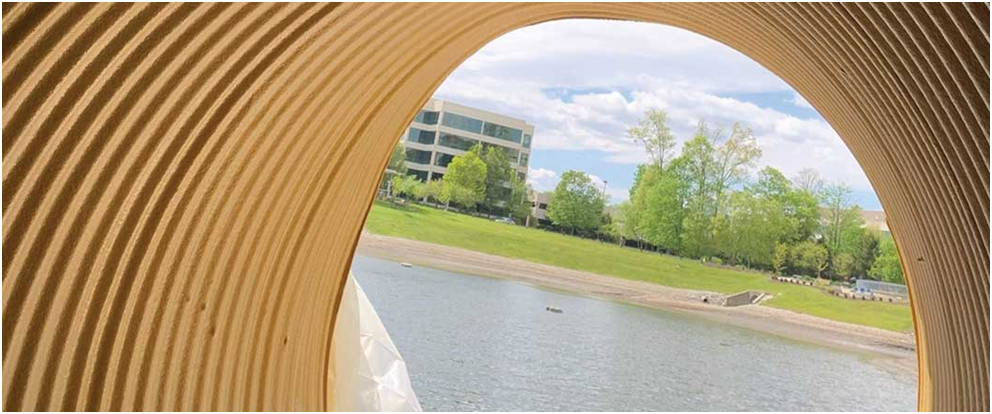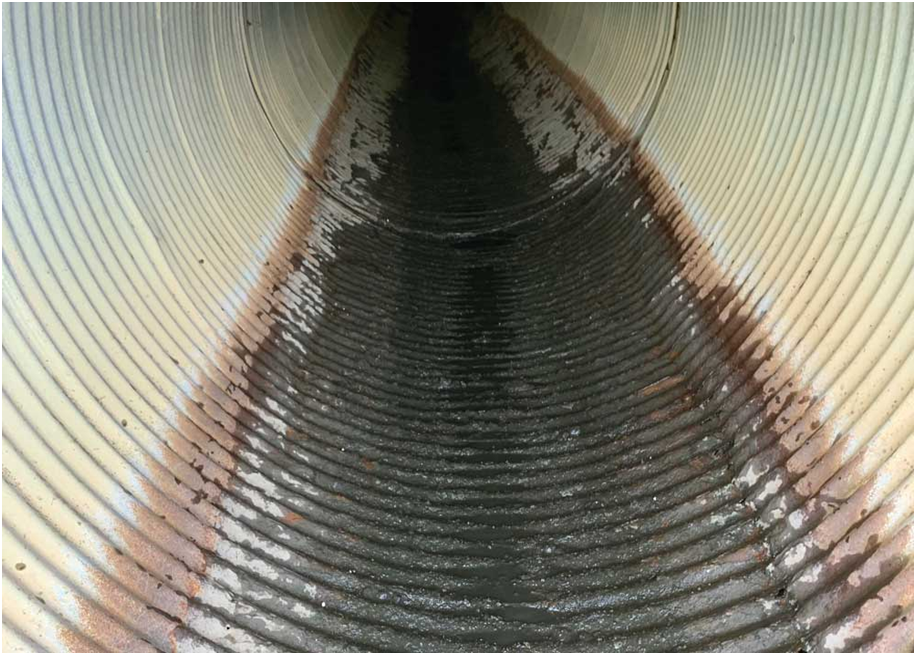印第安纳州卡梅尔市的情况非常糟糕,生锈的雨水管破裂,在主要十字路口的道路上形成了一个巨大的天坑。
幸运的是,警察赶到现场并在未发生任何事故之前确保了 12 英尺 x 18 英尺的水槽周围区域的安全。雨水管被拆除并更换,但纽约市面临另一个障碍。在被替换的部分和随时可能倒塌的排水湖之间还有另外 220 英尺长的雨水管。
由于该地区有多个公用设施以及建筑景观、人行道和标志,拆除剩余的管道不是一个好的选择。Conco Spray Solutions 是SprayWall结构衬里材料的认证施涂商,由Sprayroq在阿拉巴马州伯明翰市制造,当地承包商与当地承包商接触,以寻求对剩余管道的潜在结构解决方案。Conco Spray Solutions 与当地承包商合作,对管道进行了调查,以评估现有状况并确定其结构需求。
Spray-applied Rehab Saves Indiana Stormwater Pipe

The City of Carmel, Indiana, was in a dire situation when a rusted stormwater pipe ruptured, creating a massive sinkhole in the road at a major intersection.
Fortunately, officers arrived at the scene and were able to secure the area surrounding the 12-ft by 18-ft sink hole before any accidents occurred. The stormwater pipe was removed and replaced, but the City faced another obstacle. There was another 220 lf of stormwater pipe between the replaced section and a drainage lake that could collapse at any time.
Removing the remaining pipe was not a practical option due to the location of multiple utilities in the area and the architectural landscaping, sidewalks, and signage. Conco Spray Solutions, a certified applicator of the SprayWall structural lining material, manufactured by Sprayroq out of Birmingham, Alabama, was approached by a local contractor for a potential structural solution to the remaining pipe. Conco Spray Solutions, working with the local contractor, surveyed the pipe to assess the existing condition and determine its structural needs.

Upon assessment, it was noted that the invert had accumulated a significant amount of rust and scale. Rust and pinholing were prevalent from the 3 o’clock to 8 o’clock positions within the radius of the structure. It was also noted that there were minor deformations of the pipe in a few locations. After walking the 220 lf of the pipe in question and assessing the structural need, Conco Spray Solutions worked with the engineering staff at Sprayroq to develop a solution. Based on the assessment, it was determined that the conduit was in a Fully Deteriorated condition. This mandated that the design assumptions would include provisions for the design to include the soil load, hydrostatic load, and the live load (H-20 traffic load). Based on Sprayroq’s review, Conco Spray Solutions was certain that they could solve the problem with their application of the structural SprayWall lining.
The design input for the loads was calculated based on a hydrostatic height of 5 ft from the invert, a soil load of seven feet measured from the top of the pipe, and a live traffic load (H-20 load at 7 ft of cover). Based on the uniformity of the 220 lf, it was determined that the structural solution would be the installation throughout the conduit of 631 mils (.631 in.) of SprayWall. The structural solution factored in the reduction of the Short Flexural Modulus of Elasticity by the effects of the Creep Factor. All polymeric resin chemistries lose strength over time. SprayWall has been tested under the ASTM D2990 Standard where it was determined that SprayWall loses 28 percent of its strength at the 50-year point on its Creep curve analysis. The short-term Flexural Modulus of Elasticity of 735,000 psi was reduced by 28 percent to 529,200 psi to represent the effect of Creep on SprayWall at the 50-year timeline point. Essentially, the SprayWall design would represent the strength of SprayWall 50 years into the future.

SprayWall’s strength capability was further demonstrated in a recently concluded study at the University of Texas at Arlington. In the testing, SprayWall was installed in 60-in. corrugated conduits at 250, 500, and 1000 mils. In addition, SprayWall was also installed in 71-in. by 47-in. elliptical corrugated pipes at the same thicknesses. The lined pipes were wired with strain gauges both on the outside of the pipes and on the SprayWall on the inside of the conduits. These test samples had the inverts removed to simulate a Fully Deteriorated design condition.
After preparation, the pipes were loaded until failure. The data that was obtained demonstrated SprayWall’s ability to meet the stringent requirements required by AASHTO’s Spray Applied Pipeline Lining (SAPL) Committee. In conclusion, the polymeric resin (SprayWall), based on this testing, exceeded the AASHTO’s LRFD requirements in both geometric profiles (circular and elliptical). The LRFD design requirement is widely accepted in the United States DOT market and is a prerequisite for acceptance into the respective State DOT’s culvert rehabilitation programs. To further reinforce SprayWall’s structural capability, D-Load testing was performed in the summer of 2018 at a third-party testing laboratory. The test specimens were 48-in. reinforced concrete pipe (RCP) that were lined with the same SprayWall thicknesses of 250, 500 and, 1000 mils. The results demonstrated similar results with all the tested conduits showing a minimum increase of a doubling of the load-carrying capacity of the lined RCP as compared to the unlined 48-in. RCP.

Time was of the essence, so after the lake was pumped down, the pipe was dried and cleaned to remove debris. The Conco Spray team pressure washed the pipe surface at 5000 psi, removing the rust and spalled material that was a by-product of the corrosion in the pipe. The removal of the corrosion by-products allowed Conco and Sprayroq to further evaluate the condition of the structure’s substrate. This removal uncovered additional areas of infiltration. These repairs were made utilizing hydraulic cement. As voids were filled, more leaks became prevalent so chemical grout was utilized to finish the sealing of the substrate.

After the infiltration was halted, Conco then provided ventilation throughout the pipe to assist in the reduction of the moisture in the conduit to acceptable levels. Sprayroq’s SprayWall lining was applied to the Fully Deteriorated design thickness of 631 mils. Due to SprayWall’s quick cure, 8-12 second gel time, the SprayWall was structurally applied without having to fill the corrugations in the metal pipe. By providing a quick application and not removing the existing structure, Conco Spray Solutions minimalized the disruption of traffic flow and preserved the natural landscape in Carmel, Indiana.
